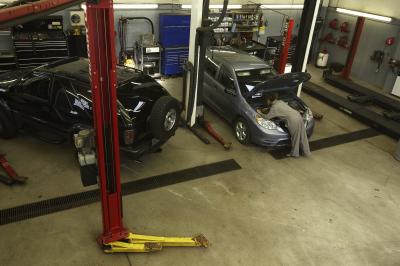
A carburetor features many segments that allow it to function under different atmospheric and demand situations. A carburetor must have a good, leak-free vacuum. The engine-produced vacuum governs the operation of everything on the carburetor. Typical vacuum on a carburetor is 18 inches of vacuum plus or minus 1 inch on a stock engine. The larger the camshaft is, the lower the vacuum. When the engine is accelerated, the vacuum drops to 0 for a fraction of a second, until the engine raises its rpm and the vacuum is restored. This fraction of a second that the carburetor has no vacuum, there is no fuel sucked out of the jets into the carburetor, causing a stumble. The carburetor's accelerator pump is designed to compensate for that momentary lack of fuel.
Remove the air cleaner. Observe the action of the accelerator pump. There is one accelerator pump on Holley carburetors up to 650 cfm. Carburetors larger than 650 cfm may have two pumps. The front pump is located on the bottom side of the float bowl on the driver's side.
Look into the carburetor with a flashlight and slowly open the throttle with the linkage. Watch for the stream of fuel to spray out of the two upper nozzles. If no spray is observed, the fuel pump diaphragm may be ripped and needs to be replaced. If the fuel does not begin to spray out immediately as the throttle is opened, the adjustment is off. Either of these problems might cause the stumble.
Replace the accelerator pump diaphragm by removing one of the bottom screws in the front of the float bowl. Place a towel or something to absorb the fuel as it empties the float bowl. Once the fuel runs out, remove the other three bolts and pull the float bowl off. Turn it upside down and remove the four screws securing the pump to the float bowl. Remove and replace the rubber diaphragm and re-install the parts.
Adjust the accelerator pump by observing the contact between the linkage bolt and the rod. The bolt should start to push the rod as soon as the linkage is moved. Adjust the bolt downward so that a good contact is made. Do not adjust it too tightly or it will shorten the stroke and less fuel will be emitted.